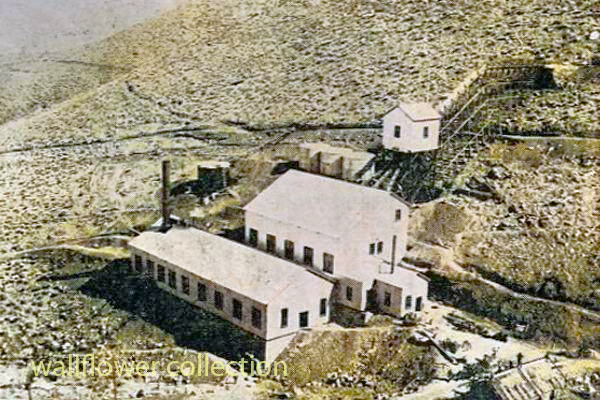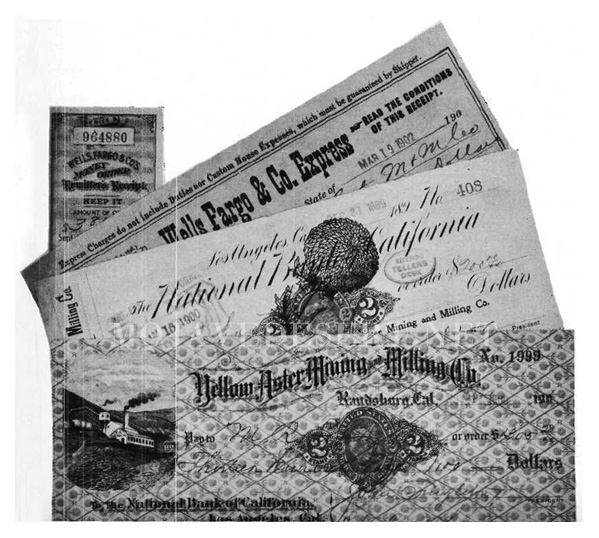The Yellow Aster
by Carl Macure - Desert Magazine - November 1964.AT THE CLOSE of the 19th century a dull explosion reverberated throughout the California Mojave desert. Its momentary shock rocked ticker tapes of Wall Street 3000 miles away.

Yellow Aster - Randsburg, Ca.
A cry of "Gold" gave birth to the fantastic Yellow Aster Mine, the mother of the town of Randsburg. From the day of her discovery in 1895 by Mooers, Singleton and Burcham up to the war year of 1942, she spewed, at current gold prices, over $60 million worth of bullion from 50 miles of entrails and half of her mountainous body. Today, unscrupulously robbed of gold-bearing quartz, this halfmountain with its timber-rotted, water-filled tunnels stands as a dormant giant overlooking its offspring, Randsburg.
At one time Randsburg boasted of a population of "500 children." Recently it was forlornly stated that the population now stands at "about 100 men, women and children and those who died only the other day." New parts of town suggest confidence in the future, with freshly painted houses and short, clean streets. But in the old part of town skeleton abodes harass the landscape and abandoned rust-ridden auto frames polka-dot its fringe, their prayer wheels challenging the strongest of men to give them a quarter turn.
From the time of my initial visit to Randsburg, I was hooked. Within a period of three months I had returned as many times. It intrigued me—its Post Office with a sign that read 1896, its White House Saloon with a long bar of carved African mahogany shipped from around the Horn and unpatched bullet holes still pocking its adobe walls.
The Yellow Aster Mill high on the hill needed no introduction. Nor did the towering half-mountain behind it, rising some 4000 feet above its gutted golden base. But that was only the outside. I wanted in.
It was Billie Blue who opened the door. Billie is the oldest living resident of Randsburg—84-years-old and once an engineer for the fabulous Yellow Aster. It was his stories that fired my desire to explore further. The "Sesame" that eventually made this possible came about through an introduction to Stewart Fraser, custodian of the mine.
My tour began.
From a 3500-foot elevation, we climbed to 4000 feet on the sharp dirt road. Already I dreaded the treacherous return. Our destination was the 50-stamp mill. Upon entering it, I was surprised to find the equipment in perfect condition. "All it takes is the word and I can have this mill operating within two months," Stewart claimed. And I believed him.
From the engine room we walked between blasted canyon walls for about 50 yards to the half-body of the Yellow Aster herself. As we stood low in the deep bowl of what had once been a fat mountain of gold ore, I felt as infinitesimal as a button.
"Don't get too close to the edges," Stewart warned. "We have a lot of slides down here when some of those boulders shake loose." As we explored tunnel after tunnel, he'd frustrate me with "That's far enough now, Carl. Let's get out while it's still safe."
As time went on, I visited Randsburg frequently. When stories of the Yellow Aster mine were recounted, I edged closer. My interest grew almost into a phobia. Then, one day—bonanza!
Stewart invited me to visit his storage place—a basement in an old building. All of the documents, papers and statistics pertinent to the Yellow Aster were stored there. Would I like to rummage around, he asked? I sure would! The combination concrete and dirt floor was literally covered with dusty crates, cartons, machinery, and newspapers. Stewart left me to myself and I went to work.
In the first carton I found dated manila packets stamped with a red wax seal. The first was dated January, 1898 and enclosed were receipts for purchases made by the mineowners. An anvil and block cost $12, a pick $1, coal 3c per pound, room and board $1 per day.
A collect telegram to John Singleton, president of the Yellow Aster read, "My son still alive. No hope for him. Will wire again in a day or two. Signed S. P. Mahan." What stories my mind conjured!
A written directive from Burcham to pay the bearer of this note a sum of $20 to be deducted from the monthly pay check of a gentleman named Ben Strug was signed received by MRS. Ben Strug! In another box I found cartons of the Yellow Aster's cancelled checks—beautiful checks imprinted with gold leaf lettering and the yellow aster insignia of the mine. One batch had 2c documentary stamps affixed. Other cartons held receipts from the old Wells Fargo and Company. These, too, carried documentary and U.S. postage stamps dated from 1898 through 1902.
I uncovered a stock certificate book of cancelled shares with gleaming gold seals. At $10 a share, the book con tained $956,590 of cancelled gold stock certificates. Best of all, I found one signed by Singleton with the number of shares and the owner's block unlisted, so I had Stewart quill my name for 100,000 shares. Now I'm a cancelled gold certificate millionaire!
Monthly time books listed the names of all mine employees. Muckers were paid $3 a day and miners $3.50. There were no Sundays at the Yellow Aster.
Perusing this material and its information, I revisited the Boothill Cemetery at Johannesburg, sister town of Randsburg, and I haunted the Silver Dollar Museum in Red Mountain, which holds relics of the mine. I can now state that within a period of three months, my imagination has lived 69 years of the Yellow Aster's life.
Throughout that 69 years, three million tons of gold ore had been processed. Its dumps still hold an additional million tons that were too costly to process even in those days.
Someday she may live again. In only one body of blocked-off ore there is an estimated $15 million of gold. However, labor costs and present gold prices render it unprofitable to mine. Nevertheless, I'd give a lot to stand on the rumbling ground as her 100- stamp mill capacity furiously ground the gold to dust.
Senior citizen Billie Blue once remarked, "It was about two in the morning, some years back. For some reason I awoke from a deep sleep. Something was wrong. It was quiet. Too quiet. The ground no longer rumbled. Then it struck me. It was the Yellow Aster mill. She had stopped."
How I'd like to see things sound right for Billie again, while he's still around to know what's going on!
